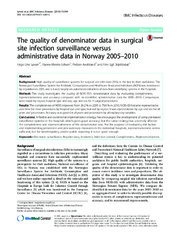The quality of denominator data in surgical site infection surveillance versus administrative data in Norway 2005-2010
Permanent link
https://hdl.handle.net/10037/8836Date
2015-11-30Type
Journal articleTidsskriftartikkel
Peer reviewed
Author
Løwer, Hege Line Magnussen; Eriksen, Hanne-Merete; Aavitsland, Preben; Skjeldestad, Finn EgilAbstract
Methods: This study investigates the quality of NOIS-SSI’s denominator data by evaluating completeness, representativeness and accuracy compared with de-identified administrative data for 2005–2010. Comparisons were made by region, hospital type and size, age and sex for 4 surgical procedures.
Results: The completeness of NOIS improved from 29.2 % in 2005 to 79.8 % in 2010. NOIS-SSI became representative over time for most procedures by hospital size and type, but not by region. It was representative by age and sex for all years and procedures. Accuracy was good for all years and procedures by all explanatory variables.
Conclusions: A flexible and incremental implementation strategy has encouraged the development of computer-based surveillance systems in the hospitals which gives good accuracy, but the same strategy has adversely affected the completeness and representativeness of the denominator data. For the purpose of evaluating risk factors and implementing prevention and precautionary measures in the individual hospitals, representativeness seems sufficient, but for benchmarking and/or public reporting it is not good enough.


 English
English norsk
norsk